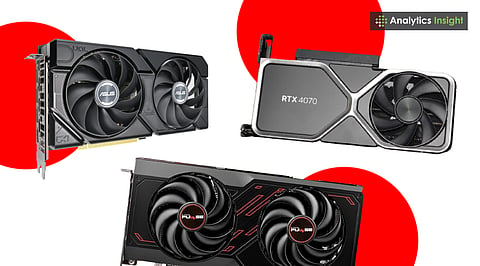

More displays require GPUs with multiple high-bandwidth outputs, such as DisplayPort 1.4 or HDMI 2.1.
Performance depends not only on GPU power but also on bandwidth, cooling efficiency, and driver stability.
Different users need different strengths - creatives may need colour accuracy, while productivity users may focus on smoothness and connectivity.
Multi-monitor setups have become a standard for professionals, creators, and power users who want to maximize screen real estate without compromising performance. Whether you are editing videos with long timelines, trading with multiple data windows open, coding with a second display, or simply want to work more efficiently, the appropriate GPU will keep all the screens on the workstation's multi-monitor system running smoothly.
A modern multi-monitor graphics card needs to deliver high-quality output with efficiency and consistent performance while handling multiple tasks simultaneously. NVIDIA's RTX line and AMD can offer the best GPUs for multi-monitor graphics, providing performance and value that enable users to create high-efficiency workstations.
Here are the best GPUs for multi-monitor setups in 2025:
RTX 4070 is highly flexible when used in a multi-monitor setup, offering excellent performance, efficient power consumption, and several high-resolution outputs. RTX 4070 can be used in multi-display systems, making it extremely preferred by creators who use 4K displays or ultrawide displays.
This multi-monitor workstation’s GPU, featuring the Ada Lovelace architecture, provides consistent performance, ensuring stable operation even when running multiple high-resource programs simultaneously. Rendering is smooth, AI tools are practical, and driver performance is stable. The RTX 4070 Super is a suitable option for users requiring moderate performance.
Radeon RX 7800 XT can also be a suitable option for users interested in a powerful multi-monitor setup without exceeding their budget. The driver ecosystem of AMD Radeon, especially Radeon Software, provides a comprehensive level of control over display setups, colour calibration, and performance tuning.
RX 7800 XT is well-suited for 4K and wide monitors, and features ample VRAM for multitasking and immersive gaming experiences. This Radeon GPU provides a seamless experience for individuals who utilize multiple screens, such as graphic designers, editors, and engineers who demand consistent performance from multiple applications running simultaneously.
Also read: AMD Radeon RX 9070 XT vs. Nvidia GeForce RTX 5070 Ti.
RTX 4060 Ti is a suitable choice for users seeking a relatively affordable yet powerful multi-monitor graphics card with 16GB of VRAM. The extra memory enables this GPU to handle large textures, multiple browser windows, streaming tools, and productivity applications across multiple screens.
4060 Ti’s low power usage makes this NVIDIA model suitable for compact workstations, and its multiple DisplayPort outputs enable easy connection to current-day monitors. This GeForce GPU suits well in home-office environments, for telecommuters, and for multitasking in general, without requiring high-quality GPU horsepower.
AMD Radeon RX 6700 XT has remained a top choice for a mid-range card in terms of multiple monitor usage, thanks to its impressive VRAM, efficient architecture, and consistent multi-display support. RX 6700 is capable of comfortably driving two or three 1440p monitors, and this GPU can be trusted to perform well when subjected to a combination of productivity, browsing, and creative workloads.
Its value offering enables it to attract users who are willing to achieve good performance on a small budget, particularly in configurations that involve coding, stock trading, or content creation across multiple screens.
Also read: Best Monitors for Dual Monitor Setup in 2025: Boost Productivity and Gaming Experience.
The best multi-monitor GPU depends on workload and budget. A balanced option for high-performance users is RX 7800 XT, while RTX 4070 Super excels in performance and multi-display capability.
These graphics cards for multiple displays are designed for budget-conscious users who want to enjoy multi-screen performance. RTX A2000, in particular, is aimed at professional workstations. Whichever model you choose, the right GPU will deliver smoother operations, brighter images, and an efficient experience when using multiple monitors.
1. How many monitors can most GPUs support?
Most modern GPUs have the capability of supporting two to three (or four) monitors, depending on the model and output ports.
2. Is VRAM important for multi-monitor setups?
Yes. Increased VRAM will be useful for processing large files, running multiple windows, and displaying high-resolution images.
3. Do I need a high-end GPU for productivity across multiple screens?
Not necessarily. Mid-range GPUs are not very good at multitasking, especially when they are under heavy 3D or video workloads.
4. Are workstation GPUs better for multi-monitor setups?
Workstation GPUs are more stable with professional software, whereas gaming GPUs can be used well.
5. Does refresh rate matter for multi-monitor performance?
Yes. A faster refresh rate also requires increased bandwidth from the GPU, particularly when the user has multiple monitors with high refresh rates.
